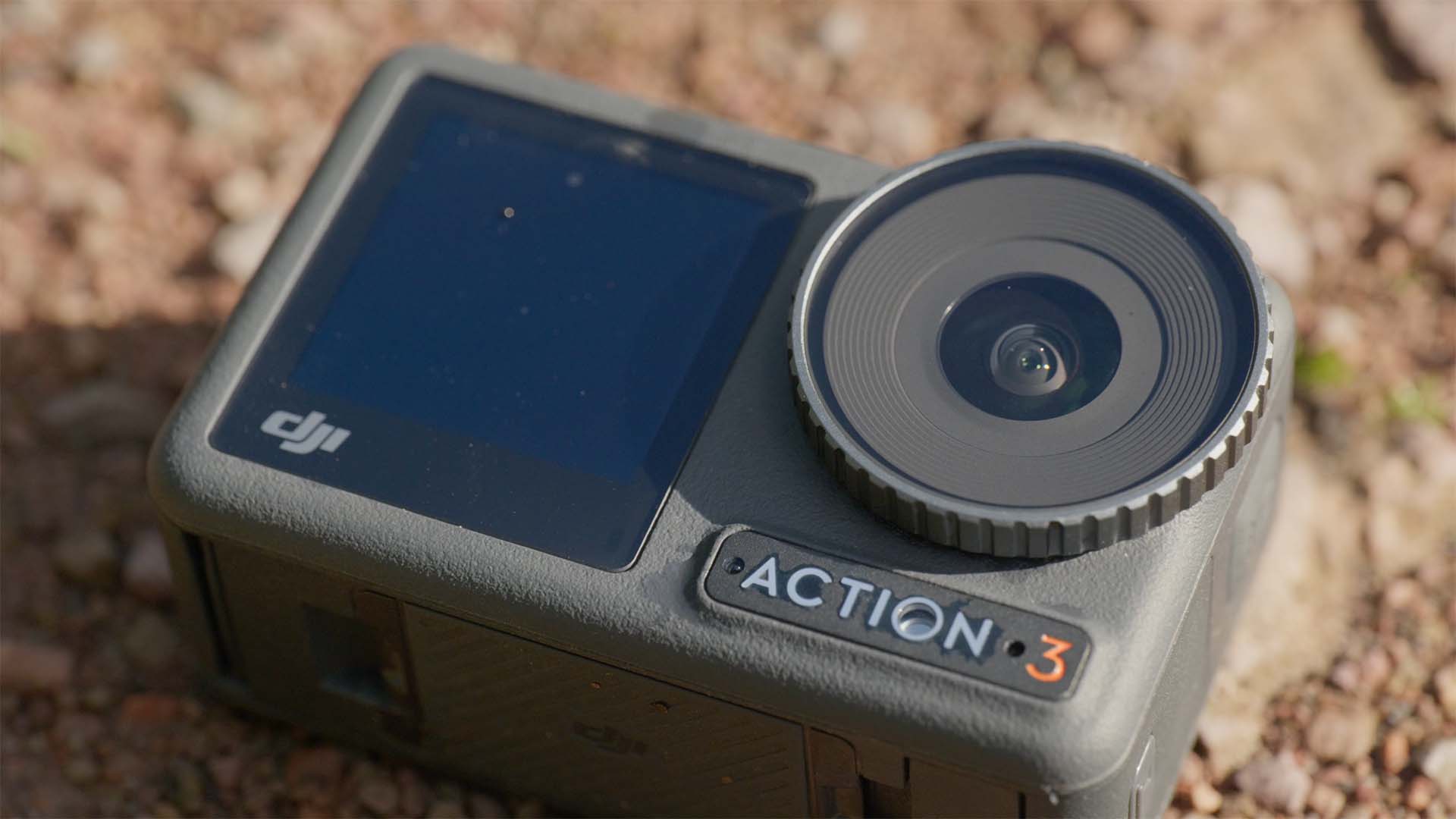
The DJI Action 3 was announced on the same day as the GoPro HERO11. Here's what we think of it.
GoPro will always be synonymous with the action camera. It is to action cameras what Hoover is to vacuum cleaners, a name so familiar that people will refer to it, even if they don't make the camera in question. So, it's a difficult market for other manufacturers to truly make their mark on.
DJI's first foray into action cameras, the Osmo Action, was a pretty successful and popular attempt to topple GoPro's crown. While it had its limitations, it built a solid fan base. It took a few years for DJI to finally release a successor, the Action 2, which was, shall we say, an 'interesting' camera.
The Action 2 had a lukewarm reception, not least by me. Its modular design was clever but perhaps too clever. As an action camera, its limitations were far and wide, and the announcement of the Action 3 a year later is an indication that DJI recognised that.
First impressions of the Action 3
The DJI Action 3 has reverted to a more traditional action camera form factor, thankfully. It's slightly more compact than the HERO11, and as you'd expect from DJI, the build quality is excellent.
The magnetic mounting system from the Action 2 is here, except it has been beefed up considerably. Even if one of the locking clips accidentally becomes undone, it is tough to pull the unit apart. If you have several magnetic mounts, it's easy to mount a few in different places and quickly move the camera between them.
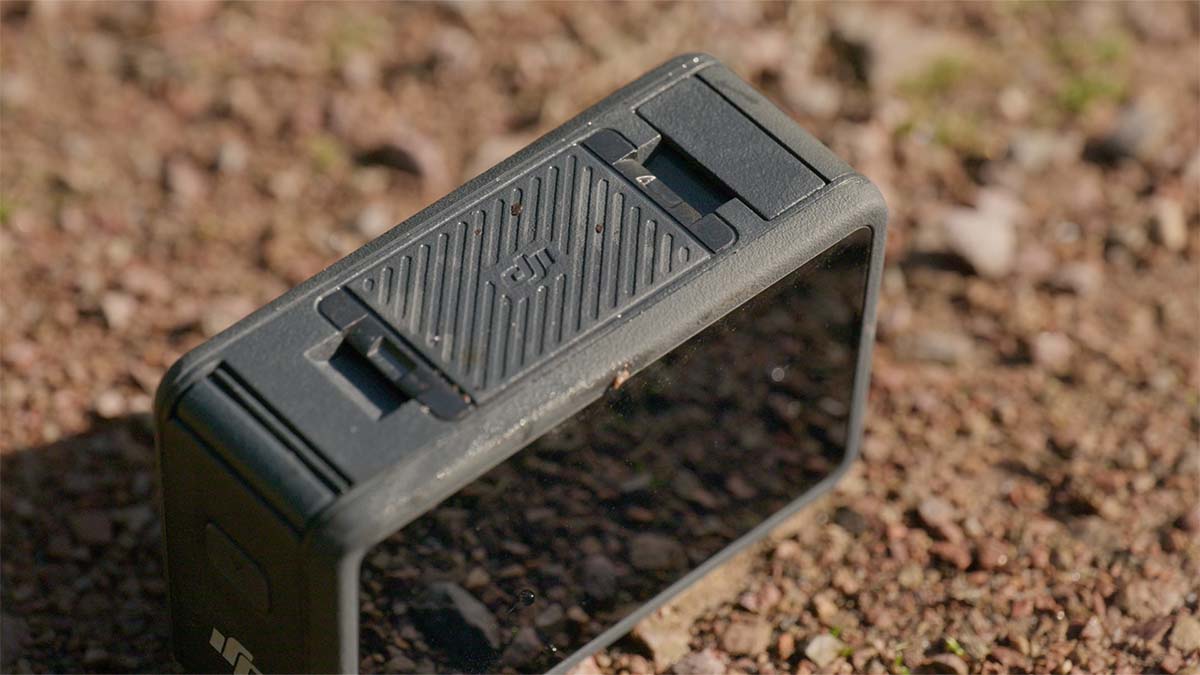
The magnetic mount system has been beefed up considerably.
DJI sent us the Adventure Combo, which includes a selfie stick, a vertical cage system, a couple of different magnetic mounts, and a clever battery charging pack with three batteries.
The battery pack will charge the batteries when hooked up to a USB power cable, but it also doubles as a power pack itself, allowing you to charge devices such as phones from it. That is, assuming you aren't using any of the batteries for your Action 3 camera. It's an excellent convenient system, a good touch.
Lastly, DJI has followed GoPro's lead and included a hydrophobic coating on the replaceable lens protector, making the Action 3 an excellent choice for watersports.
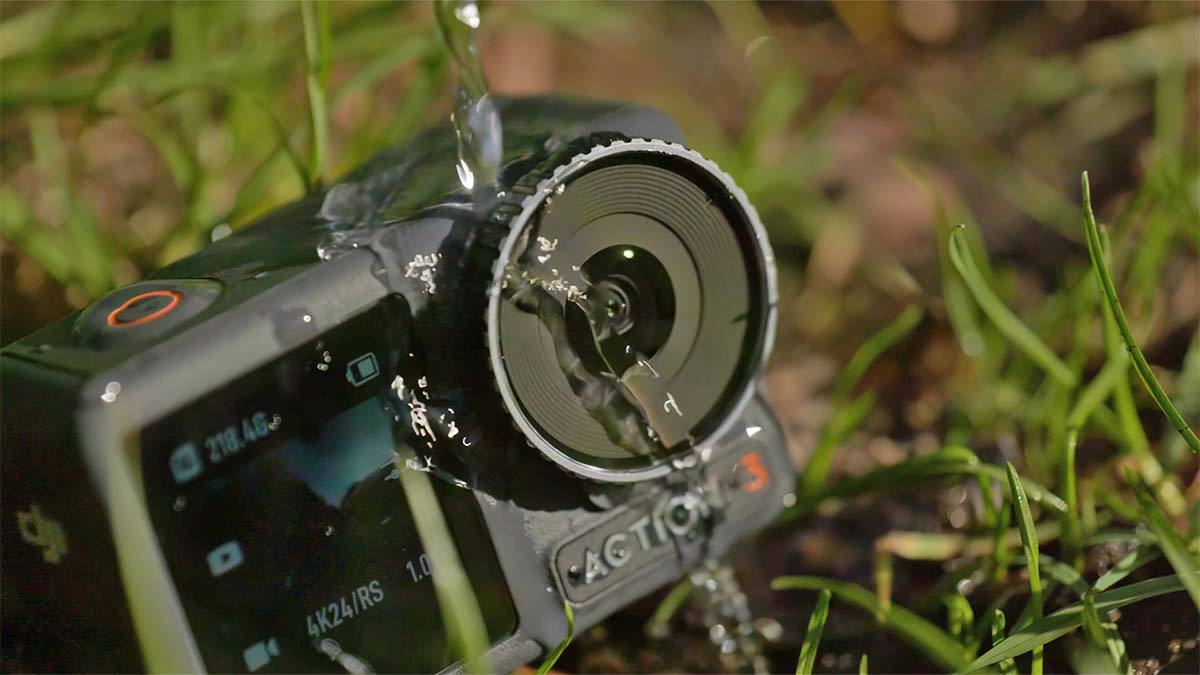
The new hydrophobic lens protector.
Action 3 video specs and modes
The Action 3 maxes out at 4K resolution, but it can achieve a maximum of 120fps at that size. You can also opt for 240fps if you drop the resolution down to 1080p. An interesting feature of the camera is that, unlike the GoPro, you can record at 48fps for precise half-speed slow motion on a 24p timeline.
The Action 3 has a choice of three different 'virtual lens modes'. Standard Dewarp eliminates the fish eye distortion and is very similar to GoPro's Linear mode. The Action 3 gives a slightly wider field of view in this mode. Wide mode is the standard setting for general use, complete with fisheye distortion, whilst Ultra-wide offers the widest field of view.
One of my primary requirements for an action camera is the broadest possible view for POV shots, and Ultra-wide mode is possibly the best wide-angle mode out there. It has less distortion than Hyperview on the HERO11 since it doesn't require a dynamic stretch but gives an even wider perspective. Top marks to DJI for including this.
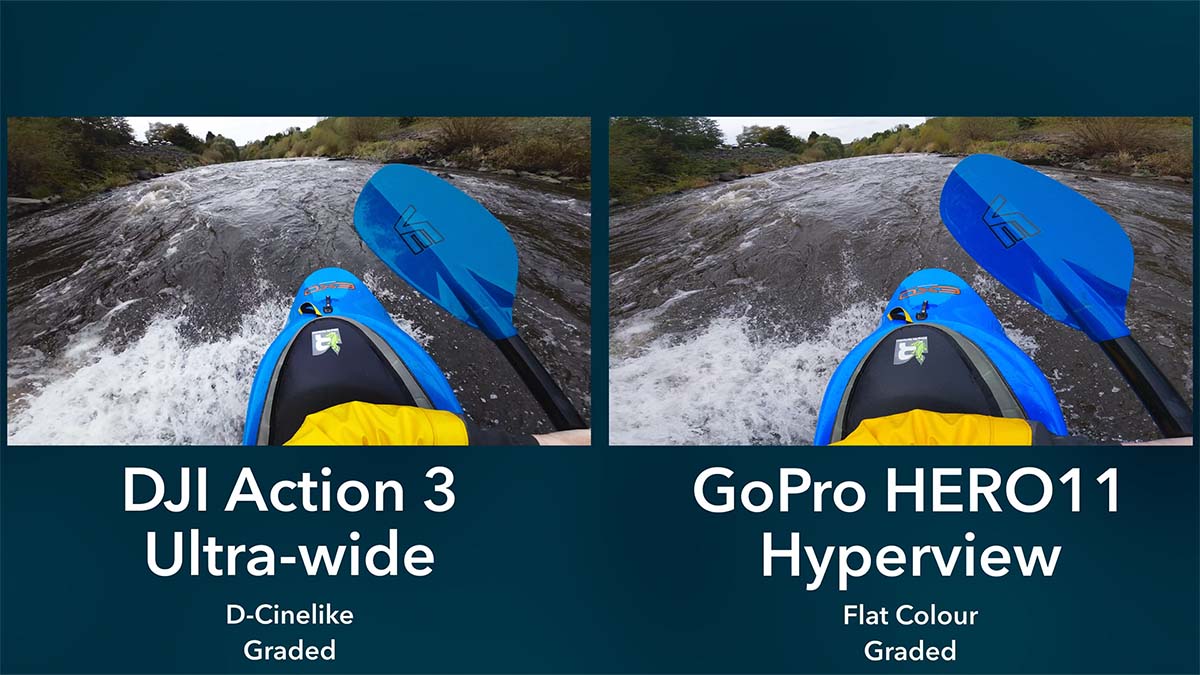
The Ultra-wide on the Action 3 vs Hyperview on the HERO11 Black. The differences look subtle at first, but the Action 3 is wider horizontally with much less distortion due to no dynamic stretching being required.
The Action 3's sensor isn't as tall as the HERO11 nor as high a resolution; however, if you want to decide your cropping in post for horizontal and vertical outputs, you can record in 4:3 mode. DJI includes a cage that allows the camera to be mounted in a vertical orientation, but if you do this, you won't be able to create dual outputs later. So, I would probably stick with 4:3 mode for this purpose.
As a side note, compared to the HERO11, the Action 3 does have a horizon levelling mode, but it only works up to 45 degrees. This will be due to having slightly less height on the sensor, preventing a full rotation of a 16:9 image without excessive cropping.
Using the Action 3
Power on times are quick and signalled by a subtle sound effect. The rear screen is bright and easy to see when you need to. A nice feature of the camera is that the front screen is also a touch screen, which is useful sometimes when using the camera in self-shooting situations. Often, I'll have an action camera mounted on the front of my boat facing backwards, and it's helpful to change settings without getting out of the boat or dismounting the camera.
Like the previous cameras, the interface is very clear and easy to use. It's also responsive, even with wet hands.
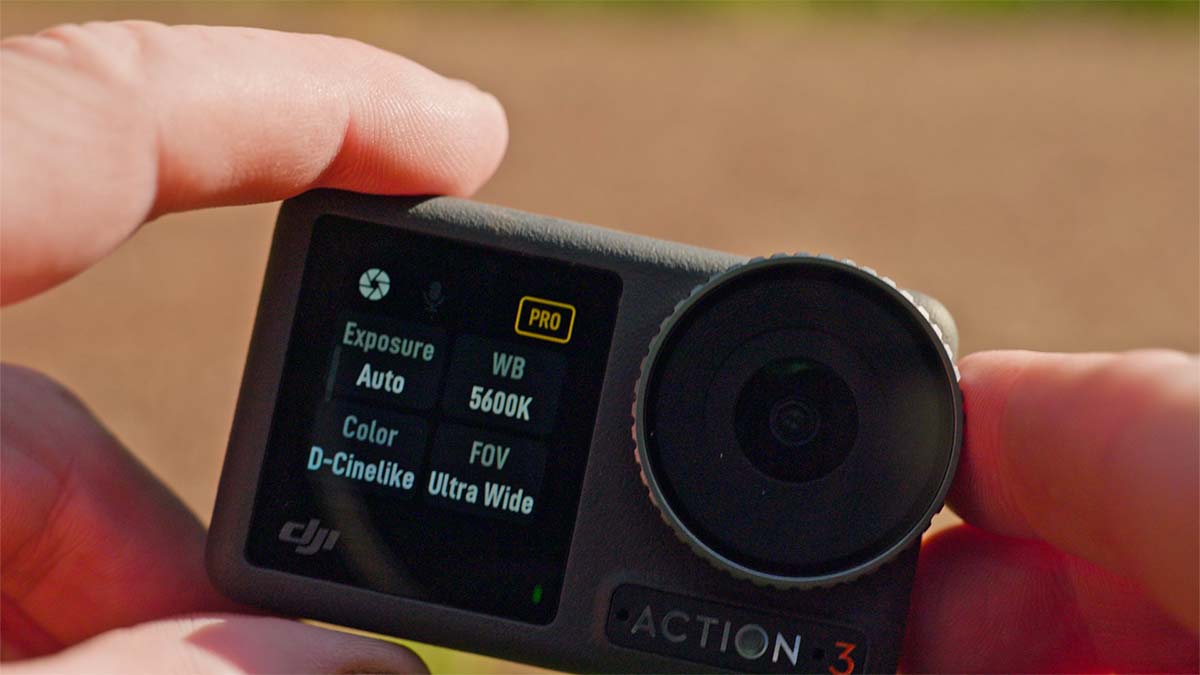
The front screen on the Action 3 is also touch sensitive.
The Ultra-wide lens mode is sublime for POV shots, and it achieves it even with stabilisation. Speaking of which, the stabilisation on the camera is excellent. My only quibble is that, unlike the GoPro, the Action 3 doesn't record gyro metadata with the video clips, so there's no way to introduce gyro-based stabilisation in post. I only mention this because, in one of my test shoots, I forgot to turn the stabilisation back on for a POV shot after I'd used it on the front of my kayak. It's a small thing, but it might be something DJI would like to consider for a future update.
Battery life on the Action 3 is, well, to put it mildly, astoundingly good. DJI says it is designed to record 150 minutes at standard frame rates in temperatures as low as -20c. I couldn't test this particular ability, but I can tell you that although I brought spare batteries when I was testing out the camera, I don't recall ever needing to swap any over. Of course, I tend only to record when I think something interesting will happen rather than keeping the camera running all the time. Still, you won't be disappointed with the record times, even on a continuous record.
I often use action cameras as training aids, placing them on the side of the river to help me improve my technique. However, in instances like this, I do need to be able to leave the camera recording for extended periods, so the Action 3's exceptional battery life would undoubtedly be helpful for anyone with a similar requirement.
The Action 3 also has a fast charging capability. Using a high-powered USB charger, the Action 3 can be charged up to 80% capacity in around 18 minutes. Again, very useful if you need to use it and realise that you haven't charged it up.
The hydrophobic lens worked very well on the river, and just like the HERO11, any droplets that did stick were tiny and soon rolled off after another splash. For me, hydrophobic lenses are now a top priority for an action camera. Even if you don't do any watersports, it is still a significant feature to have for when you are, for example, mountain biking in the rain and mud.
The Magnetic mounting system is solid, and with a few bases, it's nice to pre-empt where you want to place the camera and quickly swap between positions. My only misgiving is that there's still no tether system for the camera. GoPro makes a silicone and floaty case for the HERO cameras that both include a tether point. I use this system all the time for helmet and boat mounting, which has saved my camera from ending up on the bottom of the river on more than one occasion. So I would like to see DJI address this and create a similar range of accessories that include a tether system.
That said, the new magnetic clip system is much beefier than the one on the Action 2 and much less prone to detachment. However, mounts often fail at the base, so the camera itself does need an option for a tether.
Lastly, I found the Action 3 to be very reliable in use. I had no lockups or other errors. The camera performed flawlessly throughout.
Image quality
The Action 3 has two colour modes, D-Cinelike, which is a 'flat' mode, and Normal mode. D-Cinelike gives a desaturated look that will need grading afterwards, whilst Normal gives a good, pleasing look straight out of the camera. However, the majority of users will stick with Normal mode.
The Action 3 currently records in 8-bit colour, unlike the HERO11; however, we are aware that DJI will be introducing a 10-bit capability on the camera in a future firmware update.
Compared to the HERO11, the Action 3 doesn't have as much dynamic range, so shadows and highlights become clipped more quickly. With that said, I do like the colours that come out of the camera, and I don't think anyone who purchases it will be disappointed with the results.

Auto white balance on the Action 3 vs the HERO11.
With the GoPro, I usually manually set the white balance, and when doing this with the Action 3, I got pretty similar results, with minor differences. However, the auto WB mode was a different matter altogether. Embedded within the Action 3 logo on the front of the camera is a colour temperature sensor. This advantage is evident when comparing the two cameras in auto-white balance mode.
The GoPro tends to run much cooler in auto WB than the Action 3 and has more difficulty with mixed light, such as in a forest area with some bright daylight visible in the distance. The Action 3 coped much better with these situations, giving a good overall balance of colour.
I noticed that exposure changes are a bit too responsive on the Action 3 vs the HERO11, and perhaps future firmware can make the transition a little more subtle. There's also no way to lock the exposure with a long finger press on the relevant part of the screen. Although you can set the exposure manually using shutter and ISO settings within a menu.
Another difference between the two cameras is that you cannot adjust the sharpness on the Action 3. The digital edge enhancement is well-controlled and doesn't give an overly digital look, but I would like to see some user control over this in the future.
Conclusions
So, should you buy the Action 3 or the HERO11? Your choice depends greatly on what you will use the camera for and what type of user you are. I believe the GoPro is more suited to power users and those who wish to mix footage with larger cameras. It has more ability for users to tune the image and offer features such as the Labs firmware, which can give it some unique capabilities not found elsewhere. There are also its tethering abilities, too, via accessories.
With that said, the DJI Action 3 is a very tough competitor to GoPro for a wide range of users. The ultra-wide lens, exceptionally good battery life, excellent stabilisation and image quality make it a serious contender for your attention. At £309 for the Standard Combo, and £399 for the Adventure Combo it offers exceptional value, and for many users, it will make for the perfect adventure companion. In short, it's everything the Action 2 should have been, and I thoroughly applaud DJI for taking note and making the changes. It's an action camera I can recommend looking at without hesitation. It offers value for money and high performance in a single package.
Tags: Review Cameras Action cameras


Comments